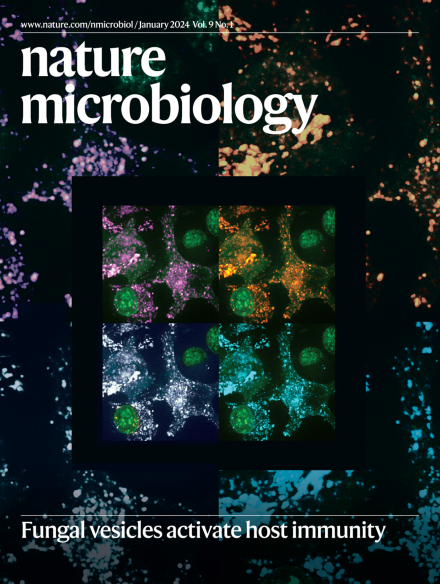Epstein-Barr virus exploits desmocollin 2 as the principal epithelial cell entry receptor.
IF 19.4
1区 生物学
Q1 MICROBIOLOGY
引用次数: 0
Abstract
Epstein-Barr virus (EBV) infects B and epithelial cells, causing various lymphomas and epithelial malignancies. Although cell-free infection of epithelial cells is inefficient, direct B-epithelial cell contact infection is highly efficient and probably the dominant route. To identify mechanisms of contact-mediated infection, we implemented a genome-wide CRISPR screen and uncovered desmocollin 2 (DSC2) as an EBV epithelial receptor and DSC3 as a co-factor for infection. DSC2 and DSC3 double knockout significantly inhibited both cell-free and cell-cell contact EBV infection of normal oral keratinocytes, while their overexpression permitted infection in receptor-negative cells. Antibodies to DSC2 blocked infection across normal oral keratinocytes, primary oral keratinocytes, and head and neck epithelial organoids. Combining DSC2 and DSC3 antibodies efficiently blocked cell-cell contact infection. Mechanistically, DSC2 interacted with the EBV gH/gL glycoprotein and facilitated epithelial fusion. Notably, EphA2 overexpression failed to restore infection in DSC2/3-deficient cells, indicating its dependence on DSC2/3. Our findings establish DSC2 as a principal EBV entry receptor and target for vaccine and therapeutic development.爱泼斯坦-巴尔病毒利用桥蛋白2作为主要的上皮细胞进入受体。
eb病毒(EBV)感染B细胞和上皮细胞,引起各种淋巴瘤和上皮恶性肿瘤。虽然上皮细胞的无细胞感染是低效的,但直接接触b上皮细胞感染是高效的,可能是主要途径。为了确定接触介导感染的机制,我们实施了全基因组CRISPR筛选,发现desmocollin 2 (DSC2)是EBV上皮受体,DSC3是感染的辅助因子。DSC2和DSC3双敲除显著抑制正常口腔角质形成细胞的游离和细胞间接触EBV感染,而它们的过表达允许受体阴性细胞感染。DSC2抗体阻断正常口腔角质形成细胞、原代口腔角质形成细胞和头颈部上皮类器官的感染。结合DSC2和DSC3抗体可有效阻断细胞间接触感染。机制上,DSC2与EBV gH/gL糖蛋白相互作用,促进上皮融合。值得注意的是,EphA2过表达不能恢复DSC2/3缺陷细胞的感染,这表明EphA2对DSC2/3有依赖性。我们的研究结果表明,DSC2是EBV疫苗和治疗开发的主要进入受体和靶点。
本文章由计算机程序翻译,如有差异,请以英文原文为准。
求助全文
约1分钟内获得全文
求助全文
来源期刊

Nature Microbiology
Immunology and Microbiology-Microbiology
CiteScore
44.40
自引率
1.10%
发文量
226
期刊介绍:
Nature Microbiology aims to cover a comprehensive range of topics related to microorganisms. This includes:
Evolution: The journal is interested in exploring the evolutionary aspects of microorganisms. This may include research on their genetic diversity, adaptation, and speciation over time.
Physiology and cell biology: Nature Microbiology seeks to understand the functions and characteristics of microorganisms at the cellular and physiological levels. This may involve studying their metabolism, growth patterns, and cellular processes.
Interactions: The journal focuses on the interactions microorganisms have with each other, as well as their interactions with hosts or the environment. This encompasses investigations into microbial communities, symbiotic relationships, and microbial responses to different environments.
Societal significance: Nature Microbiology recognizes the societal impact of microorganisms and welcomes studies that explore their practical applications. This may include research on microbial diseases, biotechnology, or environmental remediation.
In summary, Nature Microbiology is interested in research related to the evolution, physiology and cell biology of microorganisms, their interactions, and their societal relevance.
 求助内容:
求助内容: 应助结果提醒方式:
应助结果提醒方式:


